
Experts in autocracies have pointed out that it is, unfortunately, easy to slip into normalizing the tyrant, hence it is important to hang on to outrage. These incidents which seem to call for the efforts of the Greek Furies (Erinyes) to come and deal with them will, I hope, help with that. As a reminder, though no one really knows how many there were supposed to be, the three names we have are Alecto, Megaera, and Tisiphone. These roughly translate as “unceasing,” “grudging,” and “vengeful destruction.”
Yippee! We are back up!
I thought about posting this Wednesday when we got back on line, but I was feeling a little dizzy myself. (Whatever it was, it wasn’t COVID-19. I checked that out six ways from Sunday. I suspect it was something I ate Tuesday.) In any case, I’m glad I chose not to. I hope this way it will be easier to stay out of all the other great minds’ ditches. It’s in the category of “News You Can Use.” And I’ve added a couple of videos which Nameless found (and I am assuming he won’t mind me posting them here since he hasn’t done so here yet.)
==================================================================
Making masks at home – what you need to know about how to reduce the transmission of coronavirus
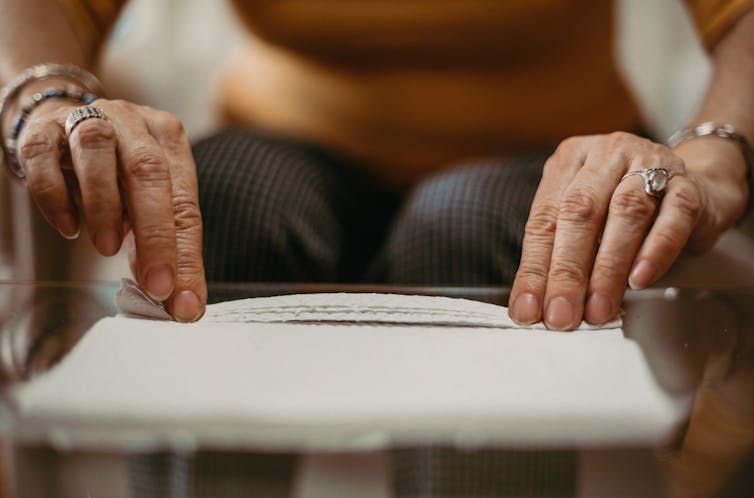
Susan L. Sokolowski, University of Oregon and Karen L. LaBat, University of Minnesota
The recent Centers for Disease Control and Prevention recommendation to use cloth face coverings to help slow the spread of COVID-19 has generated numerous how-to articles and videos. As academics who focus on personal protective equipment (PPE) research and development, we are concerned about the lack of information about two critical features of home mask design: fit and fabric selection.
The reality of particle size
Virus particles are tiny, ranging from 0.1 to 0.3 micron. A size 40 micron particle is visible with the naked eye – anything smaller, you need specialized equipment to see it.
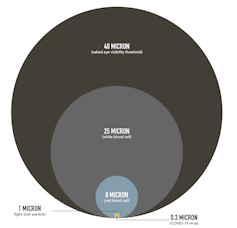
Protective masks like the N95 are designed to prevent virus particles from flowing in and out of the mask. Due to current shortages, N95 masks should be reserved for COVID-19 health care workers only.
Better than nothing
Homemade masks cannot block or filter the SARS-CoV-2 virus, because it can easily flow through every common material people have at home. However, a homemade mask is still better than none at all. If made correctly, a homemade mask can reduce the transmission of the virus from the wearer to others by impeding large droplets and spray produced by a cough or sneeze. It can also reduce the transmission of the virus from others to the wearer.
Fit
Masks should completely cover the nose and mouth. When measuring for a mask pattern, make sure it extends from the top of the nose – as close as possible to the eyes without obstructing sight – to under the chin. Masks should cover the face side-to-side, well past the opening of the mouth.
When developing prototypes, check around all edges of the mask for gaps. If you see any, close them up by pinching the fabric together, and stitch or tape or staple edges together to create a pleat or dart. A thin metal wire or paper clip placed along the top edge of the mask can stabilize and shape it along the bridge of the nose and cheekbone for a closer fit.
Masks should stay securely in position and fit comfortably with ties or elastic ear loops. If the mask is too tight or loose, the wearer may continuously adjust the mask forgetting the admonition – “Don’t touch your face!”
The ties and loops should also be the mechanism for taking off the mask, as the front of the mask might be contaminated.

Fabric selection
People have varying access to different fabrics at home. Masks should incorporate fabrics that:
-
Reduce virus transmission to and from the nose and mouth
-
Wrap around the face and are comfortable next to the skin
-
Are easy to wash and sanitize.
Fabric is comprised of four variables that must be considered for mask making: fiber, yarn, structure and finish. Change a variable – and mask performance changes.

Fibers are the smallest component of a fabric. They cannot be identified by sight or touch. Look for a fiber content label on the products or fabrics you might use for your mask. Alternately, a “burn test” can be used as a crude method to determine if a fabric is a natural fiber, human-made fiber, or a blend of natural and man made fibers. If you choose this method be careful.
There are three important fiber characteristics to consider for mask making. The first is micron size – the diameter of a fiber. The SARS-CoV-2 virus particle is 0.1 to 0.3 micron, so small-sized fibers allow for more compact fabric structures to reduce transmission. The second is how the fiber feels next to skin – this will indicate how comfortable a mask may feel next to your face. The third is moisture regain – how well the fiber absorbs moisture. A higher number means more absorbency; low regain gives a sense of how well the fiber might repel moisture.
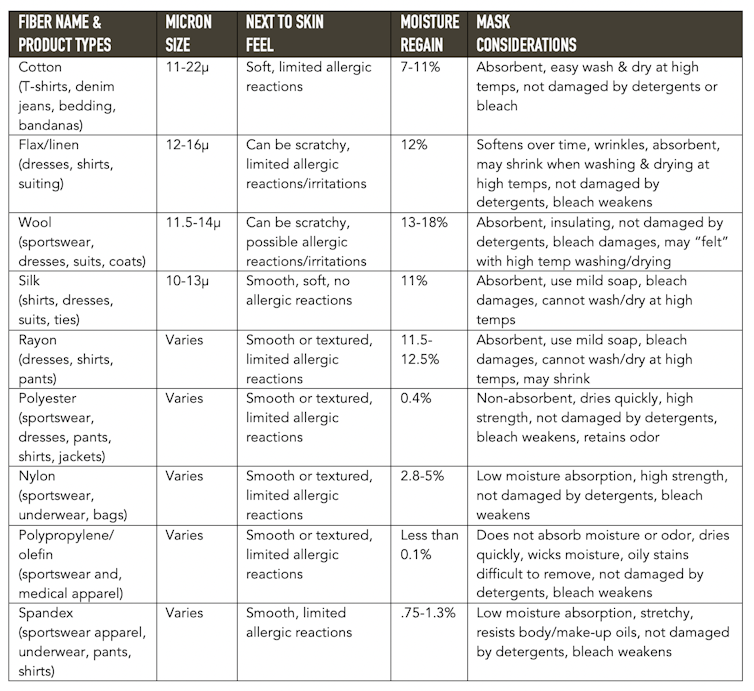
Fibers are twisted together to form yarns. Yarns vary in size affecting fabric thickness and breathability. “Yarn count” is the number of yarns in a 1-inch square of woven fabric. A high yarn count fabric indicates a dense fabric with droplet blocking potential. Yarns with different properties can be blended to combine characteristics.
Yarns are then structured into the physical fabric.
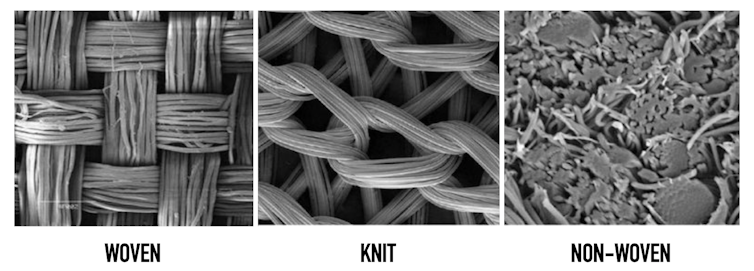
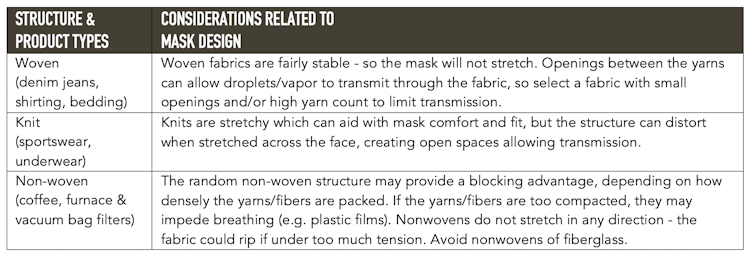
Performance finishes, like water repellency and antimicrobials, are not visible but could be helpful. Detect water repellency or moisture wicking by using an eye dropper to place a drop of water on a fabric to see how it moves across the fabric. Aesthetic finishes like graphics and batik are not so useful.
Put it all together
There are many fabric variables to reckon with for a homemade mask. Consider building a three-layer system.

This three-layer system includes a space between the inner and outer layers for a removable middle layer. A replaceable “filter” is inserted in that space. If one fabric layer is too thin, add additional layers for protection.
Homemade masks will not filter the SARS-CoV-2, however, masks may prevent droplets and spray from transmitting between individuals. When wearing a mask, remember to continue social distancing, wash hands frequently and wipe down surfaces and packages.
[Get facts about coronavirus and the latest research. Sign up for The Conversation’s newsletter.]![]()
Susan L. Sokolowski, Director & Associate Professor of Sports Product Design, University of Oregon and Karen L. LaBat, Professor Emerita of Design, University of Minnesota
This article is republished from The Conversation under a Creative Commons license. Read the original article.
/>================================================================
Knowing how masks are made helps in choosing and using them, even if you aren’t making them yourself. Notice how everything you’ve seen here, and just about everywhere else, is about making or getting them, and putting and keeping them on. But taking PPE off matters too. These are the videos which Nameless found:
AMT, we are a community here. As TC said, “The notion that Trump may … kill one of us makes me want to puke!” and if there is anything he doesn’t need, it’s more puking. So please, chide all of us to take care of ourselves, and encourage us to share any information which can help with that.
The Furies and I will be back.
15 Responses to “Everyday Erinyes #212”
Sorry, the comment form is closed at this time.

I have heard – though I can’ vouch for this – that putting a piece of paper toweling inside a mask will act as an extra filter, as well as extend the mask’s useful life.
N95 masks have a layer of paper which i believe is changeable, but I don’t know what kind of paper is used. I would think paper towels would be more porous than what the professional masks use. But it couldn’t hurt and would be easy to change out – as long as the mask is made to access the area between the layers. Thanks.
Someone sent me a snarky video by Matthew McConaughey putting a bandana facemask together with a middle layer of coffee filter, the triangular kind.
That sounded quite reasonable to me.
Looks like both a good fiber (double at thet) and a good fit. Thanks!
No, no more puking!
that is a boatload of information, thanks.
Freya, I read that too!!….somewhere! and I’ve used that too, inside my mask now, all the time. TY.
Mitchell, I agree, but it’s great info to read, re-read and store or pass on to friends/neighbors.
and finally, Joanne, Thank you for your excellent, informative post. Appreciate it!
Paper towels were up there with denim on not letting microparticles through in test results of different fabrics. Have also seen one of the tests of whether you are blocking sufficiently is whether or not you can blow out a lighter through it.
A nurse friend chose to use polypro to make masks for hospitals because it is used in making N95s.
Thanks Joanne for inclusion of container–so many I talk to do not think about protecting their car, etc. from contamination that may be on their mask.
They didn’t supply a source, so I can’t vouch for the actual numbers. But the concepts are certainly medically valid:
Good one. Wear it – and stay away from those who don’t.
Another great article with vital health information.
Wearing masks outside in public will be mandatory on Friday May 1 here in San Diego,’
Thanks Joanne
I hope you have a good one (or more). I know some pros (quilters) who are making them for people, but they are still working on orders from 4/4 and 4/5.
Australia has done really well battling COVID-19 contagion and facemasks were and are not deemed necessary but I’ll bookmark this valuable article for future reference should a second wave hit us. Thanks, Joanne!
wonderful…and So I Need A Name’s post has the single most important “cartoon” to read….
You bet. And the numbers in that cartoon show, I think, more clearly than anything else I’ve seen why Mike Pence is such an – ahem.